Nelson G. Williams, 1926-2009
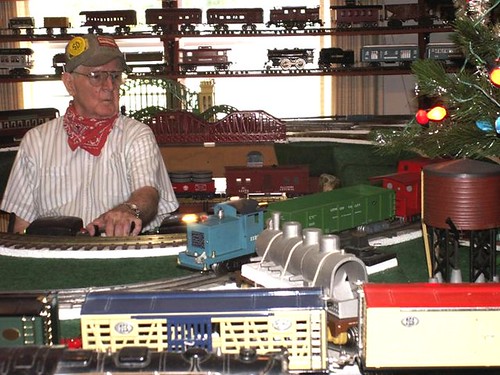
"Grandpa" Nelson G. Williams at home in June 2006
Within a month of moving to Florida, I joined Inverness Writers, a critique group located in the seat of Citrus County. There I met "Grandpa" Nelson G. Williams, one of the workshop's founding members.
Inverness Writers invited all genres. I and a couple of others brought science fiction and fantasy, but we also workshopped historicals, young adult fiction, mysteries, poetry, memoir, and other works. Nelson's specialty was focused and deep: standard-gauge model trains. I don't know how many articles he ultimately published in magazines like The Lion Roars (Lionel Trains) or The Layout (Train Collectors Association, Southern Division). He published in four national train collector club magazines alone over the course of decades, enough to earn him the title of "Tinplate Tycoon," the TCA's highest honor, in 2003.
Reading Nelson's articles taught me a brand new vocabulary. The following comes from his article, "Two Dorfans in One Season," The Train Collectors Quarterly, October 1996 (read the .pdf here). This seems to be an old OCR conversion, so I've taken my best guess at correcting software mis-translations.
"Why was I so excited about getting a Dorfan freight train?
"I collect only 2-1/2-inch Standard gauge tinplate trains - the classics made before World War II, and the modern trains built since 1965. I already had nearly all the Lionel freights since 1910, an Ives and an American Flyer, and a few passenger sets. But I still needed a Dorfan (and a Boucher) to complete my collection of classic freights.
"Dorfan was founded In 1924 by Milton and Julius Forchhelmer, cousins of Joseph Kraus and former executives of his toy company in Nuremburg. Kraus himself emigrated to the United States about 1930. Their trains were named after their mothers, Dora and Fanny, being called 'Fandor' In Europe and 'Dorfan' in America. Otherwise, the Dorfan company in New Jersey was completely independent. At first [Dorfan] designed and built 0 gauge trains, adding Standard gauge about 1927.
"Their idea was to market trains as educational toys. The engines were designed so a boy with a screwdriver could put the halves of the body together or take them apart. He could service the motor himself, and learn some basic facts about electricity."
Many of Nelson's articles focused on teaching younger readers a history of train collecting. Some incorporated personal details within the hobby and its supporting trades, letting readers see into the lives of Glenn Gerhard, "Red" Forney, the McCoys, and other model train builders who turned their passion into a business. Nelson kept in personal contact with these pioneers and their families. The following comes from a draft I've pulled from my workshop notes, of Nelson's article, "Glenn Gerhard and the Trains He Built."
"Glenn's father got his son a 'Baby State Set' from the Lionel factory at Irvington when Glenn was three. Later, Glenn salvaged a 10E locomotive and a flat car from a neighbor's fire. Dad cut a yardstick to make the flat car into a gondola with wooden sides and ends, like the first car Joshua Lionel Cowen made in 1901. Glenn chose the 'Lionel Handbook for Model Builders' as his Christmas present in 1941 and a 512 gondola in 1942. After the war he got a green Lionel 517 caboose at Macy's.
"Glenn was too ill to attend school at ages 13-14, and spent time making his own rolling stock. As a Boy Scout project, he made a Pennsylvania Railroad X29 out of wood, with balsa doors and a button for the brake wheel. He also built a boxcar from a wooden cheese box, a 65-foot mill gondola of cardboard, and an H0 Atlantic steam locomotive of wood and cardboard on a hand-filed brass frame, with a Mantua motor, drivers, and gears.
"Such a boyhood might have led Glenn Gerhard to go to work for a railroad, but history and life are not that logical. Instead of riding the rails, he became an over-the-road truck driver, hauling goods over interstate highways as a lifetime career."
Nelson's love of model trains stemmed from a long family tradition, which he wrote about in "A Century of Toy Trains in my Family," The Layout 43(3), Summer 2009 (read the .pdf here).
"Within my own family I am Grandpa Nelson III. There were not just three generations between us, but six generations of toy trains among us in the 20th century. Our first one was a cast iron locomotive that Dr. Hezekiah Wallace Nelson gave to my father 100 years ago. That was soon after Joshua Lionel Cohen built his first 2-7/8” gauge freight cars and trolleys.
"I never saw my father’s locomotive, but it was probably an Ives because it smoked his Grandpa Nelson’s cigar in its smokestack. The cigar was kept puffing by a bellows with connecting rods to the big drive wheels. It was a holiday gift, perhaps when Dr. Nelson lived with Grace’s family several years before his death in 1913.
"I still have the next toy train in our family. It was a Lionel 2-1/4” standard gauge freight set purchased in 1937 at the J.L. Hudson store in Detroit. My father was all thumbs, but he set up a circle of track around the Christmas tree, wired the transformer and rheostat correctly, and showed us how to run it ourselves. He may never have touched it again but he loved to hear its whistle over the telephone when he was on the road as a travelling salesman."
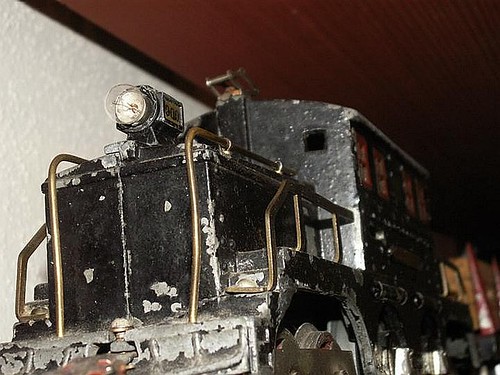
Nelson's first train, which I believe was manufactured in 1903.
Nelson was also active in transporting portions of his vast collection to exhibits around Florida, another subject in his articles. "Little Generals of the Civil War" (The Layout, 43(2), Spring 2009; read the .pdf here) guides the reader through the story of The General ("kidnapped from the Big Shanty depot northwest of Atlanta in 1862 By Andrew’s Raiders") and then through a variety of model trains copying the famous locomotive.
"My display of small models of the General was seen by more than 3500 visitors during the 13th annual 'Trains at the Holidays' in December at Ocala. I also showed most of my 'Gondolas, Hoppers, and Dump Cars' there. The major operating layouts of the Ocala Model Railroad Club and the Ocala 3-Railers were their largest ever at Central Florida Community College."
Nelson also brought some of his trains to our meetings at Lakes Region Library, and hosted meetings in his home on those few occasions when the library closed for staff training.
A retired lawyer, Nelson had also been a newspaperman, textbook author, and award-winning college editor. Throughout the brief years I was privileged to know him, I most remember his generosity, hand-in-hand with his bluntness. As a critique partner he was not one to mince words, but he took as good as he gave. He was a man of striking joie de vivre who lived life to the fullest, regardless of what life dished out. I remember his humor and wit, and his unfailing service in myriad capacities -- in law and politics, in the Parkinson's support group for which he and his longtime partner Alice (deceased) volunteered, and elsewhere, in addition to the TCA. I remember an at-times cocky demeanor that didn't quite hide a modest soul. Nelson chaired Inverness Writers from the time I joined in 2003 until his death earlier this week.
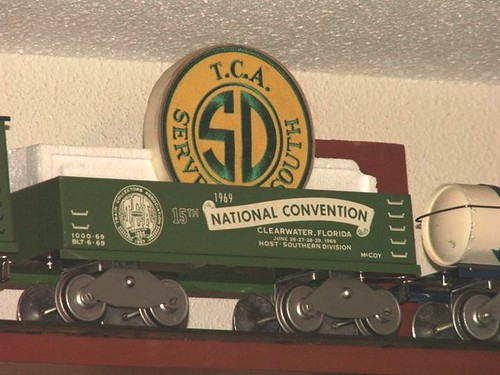
My photo of the 1969 TCA National Convention Car appeared in The Layout 40(4), Fall 2006 (Vol. 40 No. 4), accompanying Nelson's article, "40th Anniversary Trains: The Real McCoys 1966-98."
Nelson did not write for pay, but he loved what he did.
You can see my full photoset of Nelson's train collection here.
A Video of Nelson's Trains
My heartfelt condolences go out to Nelson's family and friends, and to my fellow workshop-mates who knew him.
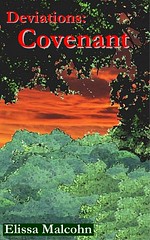 | 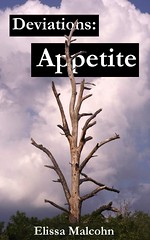 |
Vol. 2, Deviations: Appetite
Free downloads of both volumes here.
 | Go to Manybooks.net to access Covenant and Appetite in even more formats! |











1 Comments:
This comment has been removed by a blog administrator.
Post a Comment
<< Home